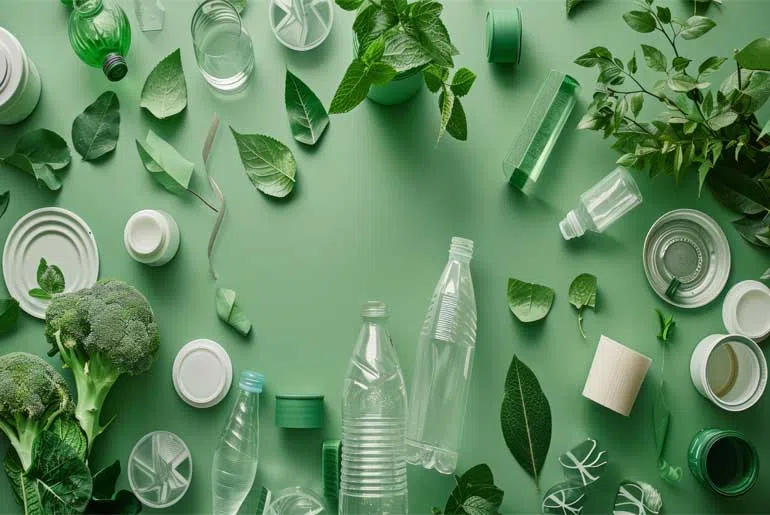The search for more sustainable solutions to the global plastic pollution problem has placed bioplastics at the center of the debate. Produced from renewable sources, such as sugarcane, they offer a less polluting alternative to conventional plastics derived from fossil fuels. However, a recent study conducted by the National Laboratory of Biorenewables (LNBR), part of the National Center for Research in Energy and Materials (CNPEM), warns that the true positive environmental impact of bioplastics will only be achieved with efficient recycling management. The research, published in the renowned scientific journal Nature, provides a detailed overview of the challenges and opportunities associated with the production and use of bio-based plastics.
Brazil holds a strategic position in the global bioplastics landscape due to its abundance of natural resources, such as sugarcane, and its extensive experience in ethanol production, a key input for bio-based polyethylene (bioPE). According to the study, the country has the potential to lead this transition sustainably, without significant impacts in terms of increased cultivated areas, biodiversity loss, or water resource scarcity.

The study modeled possible scenarios up to 2050, considering the priority use of degraded pasture areas for sugarcane cultivation. This approach could transform underutilized areas into productive spaces, promoting environmental gains such as increased carbon stocks in the soil, biodiversity conservation, and reduced pressure on water resources. The study’s ideal scenario foresees the use of 3.55 million hectares in Brazil, which would meet a significant portion of global demand, estimated at up to 22 million hectares.
The states of São Paulo, Mato Grosso, and Mato Grosso do Sul are identified as the main candidates for hosting these new cultivation areas, due to their established agricultural infrastructure. However, these regions face additional challenges, such as the increase in wildfires, as identified in reports from the National Institute for Space Research (INPE). This scenario reinforces the importance of sustainable management strategies and public policies that promote environmental protection.
Petroleum-based plastics currently consume between 5% and 7% of global oil production and are responsible for approximately 2% of greenhouse gas (GHG) emissions. Without significant changes, these proportions could rise to 20% of oil consumption and 15% of global carbon emissions by 2050, an alarming scenario.
In this context, bioplastics emerge as a promising solution. BioPE, produced from raw materials such as sugarcane, offers significant advantages in terms of carbon emission reduction. In addition to sugarcane, other crops, such as cassava, sweet potatoes, and coconut fibers, are being explored as potential renewable sources for plastic production, but sugarcane stands out due to its high productivity and the established industrial infrastructure in Brazil.
Despite their environmental potential, bioplastics are not biodegradable, meaning that improper disposal can generate the same environmental issues associated with conventional plastics, such as ocean pollution. The lead researcher on the study, Thayse Hernandes, a PhD in Energy Systems Planning from the University of Campinas (Unicamp) and leader in Biodiversity and Ecosystems at CNPEM, emphasizes that recycling is one of the greatest challenges for this technology.
“Although bioplastics are biologically sourced, their main advantage is their ability to store carbon and reduce CO2 in the atmosphere. However, if disposal is not controlled, they will have the same negative impact as fossil plastics, especially in environments like oceans,” Hernandes explained.
The researcher emphasized that, although production technologies are already advanced, it is crucial to invest in efficient collection and recycling systems. According to her, the issue is not just technological but also social and governmental. “It is necessary to engage local, state, and federal governments to organize collection and ensure that these materials return to the production chain, avoiding irregular disposal that compromises all sustainability efforts,” she stated.
In scenarios where recycling is not efficient, the study warns of a range of potential problems. Bioplastics production could compete with other agricultural crops, create tensions in local communities, and even provoke conflicts in environmentally protected areas. Furthermore, a lack of management in disposal could exacerbate climate issues and undermine the viability of low-carbon projects.
These challenges highlight the need for an integrated approach that combines technological advances, effective public policies, and social awareness. Governments, businesses, and society must work together to create a sustainable value chain for bioplastics, which includes everything from production to responsible disposal.
With the potential to significantly reduce carbon emissions and promote the transition to a low environmental impact economy, bioplastics represent a unique opportunity. However, the success of this transition depends on factors beyond technology. Efficient governance, environmental education, and societal engagement are key to ensuring that this solution truly contributes to global sustainability.
The CNPEM study serves as a powerful reminder that technological innovations alone are not enough to solve environmental challenges. Only with a holistic approach will it be possible to transform bioplastics into a viable and sustainable solution for one of the greatest environmental problems of the 21st century.
The LNBR study makes it clear that bioplastics, especially bioPE produced from sugarcane, have the potential to become a sustainable alternative to fossil plastics, significantly contributing to carbon emission reduction and mitigating environmental impacts. However, this transition depends on coordinated efforts on multiple fronts.
It is essential that production aligns with sustainable agricultural practices, prioritizing the use of degraded areas and minimizing land use conflicts. Furthermore, efficient governance, with a focus on collection and recycling, will be crucial to prevent bioplastics from following the same path of environmental pollution as traditional plastics. The active participation of governments, businesses, and society is essential to building an integrated and circular value chain.
Bioplastics are not just a technological solution but an invitation to rethink production and consumption models in search of a truly sustainable economy. With Brazil in a prominent position in this scenario, the country has the opportunity to lead this global change, showing that it is possible to combine economic development with environmental preservation.

